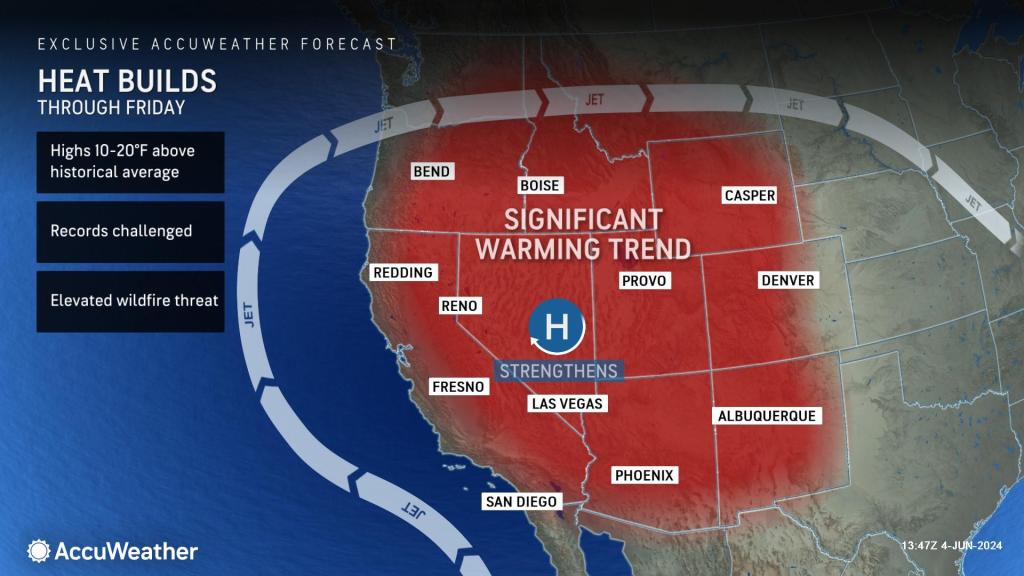
Phoenix and Las Vegas are among the cities that will experience blazing heat in the West this week — and the widespread hot and dry conditions will escalate the wildfire threat across the region.
AccuWeather introduces the only scale that tracks the duration and severity of heat waves.
The first widespread heat wave for the western United States is building and will last through the end of the week. AccuWeather meteorologists warn that heat and dryness will boost the risk of wildfires in some situations.
The combination of a bulge in the jet stream, high pressure building at most levels of the atmosphere and a storm offshore of California will allow the heat to build without any shower or thunderstorm activity for about 50 million people in the West through at least Thursday.
The National Weather Service defines a heat wave as a period of abnormally hot weather, with or without high humidity, lasting more than two days. Heat waves can be dangerous, especially for those who cannot take a break in a cool environment. Experts urge people to take it easy and keep hydrated as the heat wave builds.
AccuWeather RealFeel® Temperatures will surge along with the heat in the West and will reach dangerously high levels as far north as Northern California.
Not only will it get hot across much of the interior West, but daily temperature records will also be challenged.
In Fresno, California, temperatures are projected to be around 105 F from Wednesday to Friday, within a few degrees of record highs dating back to 1903.
Prior to this week, the hottest day in Fresno for 2024 was May 31, when the temperature hit 96.
“It’s been a similar story on Redding, California, farther to the north, with highs to range from 103 to 107 from Wednesday to Friday,” AccuWeather Meteorologist Brandon Buckingham said. Records set in 2016 will be challenged on Wednesday and Thursday. The temperature reached 98 F on May 31 for the season high prior to this week.
East of the Sierra Nevada, highs in the mid- to upper 90s will also challenge records in Reno, Nevada.
While places closer to the coast, such as Los Angeles and San Francisco, as well as Seattle, are projected to have highs in the 60s and 70s, locations farther inland, such as Las Vegas and Phoenix, will be scorching for much of the week with daytime temperatures soaring above the 100-degree mark, AccuWeather Meteorologist Alyssa Glenny said.
GET THE FREE ACCUWEATHER APP
-
Have the app? Unlock AccuWeather Alerts™ with Premium+
In Las Vegas, temperatures are forecast to hit 108 on Wednesday, 112 on Thursday and 110 on Friday. Correspondingly, records each day are 109 set in 2016, 110 set in 2010 and 109 set in 2013.
Temperatures are forecast to reach at least 110 degrees in Phoenix from Wednesday to Friday.
The Corral Fire in San Joaquin County burned 14,000 acres as of Sunday afternoon. Firefighters continue to work on containment lines.
The searing heat and blazing sunshine overhead is a perfect recipe for brush fires. Even though deep soil moisture is plentiful and most trees are well-watered following two winters of ample rainfall and mountain snow, the topsoil can dry out quickly.
This can lead to flash soil drought conditions, and some quick-burning fuels, such as grass, can rapidly become primed for ignition.
A grassland fire broke out on Saturday east of San Francisco and quickly grew to more than 14,000 acres as of Sunday night and prompted evacuations in a nearby community of Tracy, California.
“The Corral Fire has become the first 10,000-acre fire this year,” Buckingham said, “And given the heat, dryness and sunshine this week, there will likely be more fires breaking out that can quickly spread.”
According to the United States Drought Monitor, more extensive and deeper soil drought conditions are expanding over parts of the interior Southwest, especially in New Mexico and parts of West Texas.
Recent heavy rain in much of the Northwest will keep the risk of wildfires low in the short term.
In terms of thunderstorm activity, the upper levels of the atmosphere will begin to cool slightly Friday, and that trend will continue through the weekend. While this will begin to take the edge off the extreme heat and result in a slight cooling trend in much of the region, it will also make it possible for thunderstorms to erupt over the Rockies and Intermountain West starting as early as Friday afternoon and continuing through the weekend.
In such situations, experts advise hikers heading into the mountains to get an early start and allow enough time to move off the ridges as storms erupt in the afternoon. Being on a ridge or above the tree line can be very dangerous as thunderstorms rapidly erupt in the afternoon.
Want next-level safety, ad-free? Unlock advanced, hyperlocal severe weather alerts when you subscribe to Premium+ on the AccuWeather app. AccuWeather Alerts™ are prompted by our expert meteorologists who monitor and analyze dangerous weather risks 24/7 to keep you and your family safer.
Report a Typo